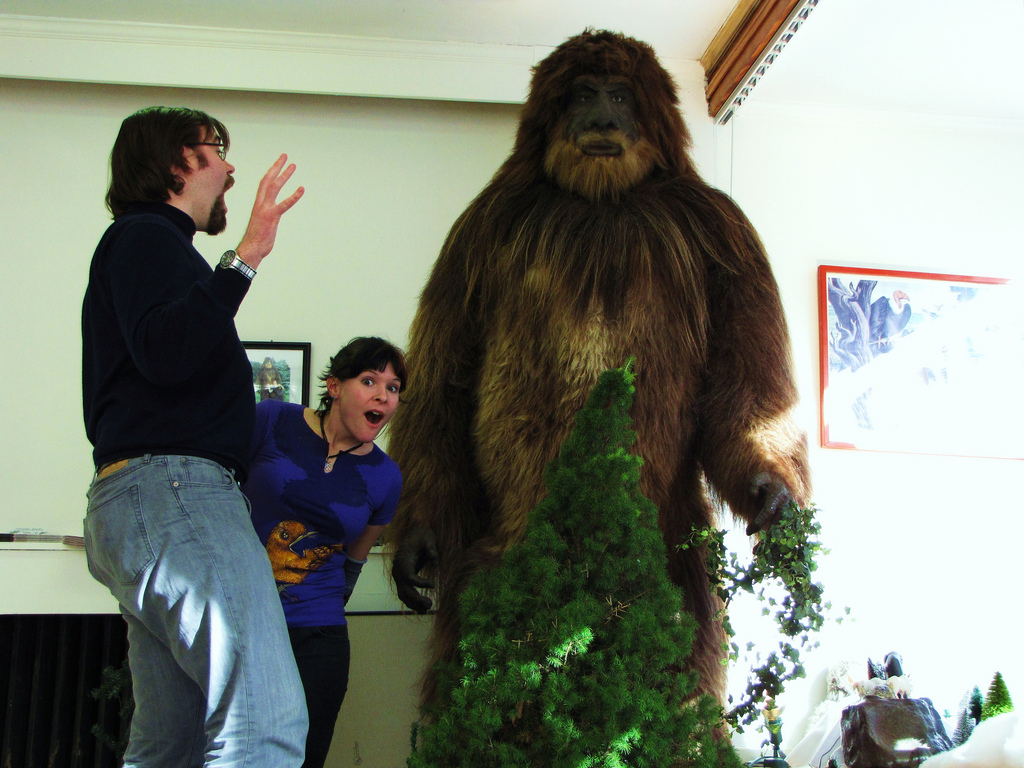Selling Sasquatch
Posted by: Loren Coleman on February 28th, 2010

Some recent visitors to the museum. Do you recognize them?
Ian Clark has given permission to post his last Sunday’s Manchester New Hampshire Union Leader and Sunday News column:
LET’S TALK about Bigfoot.
What does Bigfoot have to do with pop culture? Well, judging by the legendary creature’s appearance in commercials and as one of the Olympic mascots (Quatchi) at the Vancouver games, Bigfoot has clearly become a pop culture icon.
Loren Coleman is one of the world’s leading cryptozoologists (folks who study “hidden,” as in undiscovered, species). Coleman is the author of numerous books on varying “cryptids” such as Bigfoot, “Mothman” and lake monsters.
Coleman is a frequent guest on radio and television programs dealing with legendary creatures. He also runs the International Cryptozoology Museum in Portland, Maine.
According to Coleman, the pop culture surge with Bigfoot (also known as Sasquatch) and the Yeti began several years ago when the “bumble” from Rudolph the Red-Nosed Reindeer became a merchandising tool.
“The Yeti, or Abominable Snowman, has become a Christmas icon,” Coleman said. “The native peoples of the Himalayas talk about this as a much more ape-like creature that’s brown. But popular culture has swayed Americans into thinking that yetis are white. That’s due to (the bumble). The resurgence of that really started a few years ago.”
Coleman’s studies also include the pop culture elements of the creatures, sightings, and accounts that date back to the 1800s. He points out that Americans tend to use Bigfoot in a violent vein. Canadians, on the other hand, seem to prefer a cuddly creature.
“As far as Quatchi, there’s this softer, almost greeting card approach that’s happening on another level,” Coleman said. “Up in Canada, they seem to be appreciating the more softer side of Sasquatch.”
Aside from pop culture, many people associate Bigfoot with hoaxes, such as the 2008 debacle where two Georgia men claimed to have found the dead body of a sasquatch and managed to get themselves on CNN.
The media seems to latch onto these fabricated events, which Coleman says are only about 1 percent of the cases he sees. These can cast a bad light on a subject that is seriously researched by people such as Coleman and anthropologist Dr. Jeff Meldrum.
“I’ve been doing this for 50 years as of March,” Coleman said. “We in the field know that 80 percent of all the cases that come to us are pure mistakes, misidentifications (of) mundane animals, and people making errors that eyewitnesses make. The other 20 percent are those good kernels of information that keep us going on.”
Encounters with Bigfoot-type creatures (tall, hair-covered beings that walk on two legs) have been reported in nearly every state of the U.S. (yes, even New Hampshire).
Folks interested in getting a look at possible evidence for the existence of these animals (such as footprint casts) should jaunt over to Portland to check out the museum, which has had more than 1,500 visitors in just three months. Admission is only $5, and Coleman himself leads the tour (assuming he is not away on business).
Ian Clark is a reporter with the New Hampshire Union Leader and Sunday News.
About Loren Coleman
Loren Coleman is one of the world’s leading cryptozoologists, some say “the” leading living cryptozoologist. Certainly, he is acknowledged as the current living American researcher and writer who has most popularized cryptozoology in the late 20th and early 21st centuries.
Starting his fieldwork and investigations in 1960, after traveling and trekking extensively in pursuit of cryptozoological mysteries, Coleman began writing to share his experiences in 1969. An honorary member of Ivan T. Sanderson’s Society for the Investigation of the Unexplained in the 1970s, Coleman has been bestowed with similar honorary memberships of the North Idaho College Cryptozoology Club in 1983, and in subsequent years, that of the British Columbia Scientific Cryptozoology Club, CryptoSafari International, and other international organizations. He was also a Life Member and Benefactor of the International Society of Cryptozoology (now-defunct).
Loren Coleman’s daily blog, as a member of the Cryptomundo Team, served as an ongoing avenue of communication for the ever-growing body of cryptozoo news from 2005 through 2013. He returned as an infrequent contributor beginning Halloween week of 2015.
Coleman is the founder in 2003, and current director of the International Cryptozoology Museum in Portland, Maine.









